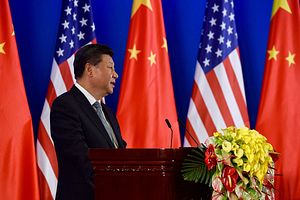China’s rise, which has long been described as a “miracle,” has been phenomenal. Beijing has successfully imported a market economy while marvelously sustaining its own unique political system. Beyond that, the unprecedented and successful combination of a market economy and an authoritarian political system has been called a “model” for many developing countries that suffer from various problems such as a large and poor population, low national income, and previous or even ongoing political instability. There even was a debate in academia over the two patterns, or paradigms, in international political economy: the “old” Washington Consensus vs. the “new” Beijing Consensus.
However, a few years ago, when the world “hailed” the forthcoming “G2” era, China did not show much enthusiasm. Some claimed that China had already become the biggest world economy by purchasing power parity (PPP), but the truth is that China did not want to be “number-one” (in Chinese 被第一). Though today, the “Chinese Model” is still an international media catchphrase, it seems that the Chinese are talking more, themselves, about initiatives, proposals, and more recently, solutions (in Chinese 方案). For example, in a speech delivered at a rally marking the 95th anniversary of the founding of the Communist Party of China (CPC) last year, Chinese President Xi Jinping said that “the Chinese people are confident in providing a Chinese solution to mankind’s exploration of better social systems.” In my view, this is an important change, and a clearly, a very necessary one.
In political discourse, terminologies like “model,” “strategy,” and “paradigm” are some of the terms repeatedly referred to in discussions of a great power’s rise; but sometimes they may be too “heavy” to describe China’s current international participation in world affairs.
Take “model” as an example. Beijing has always implied that the so-called “Chinese Model” is completely a Chinese-style developmental process with completely Chinese characteristics. Therefore, it may not be duplicable elsewhere; it is, of course, not universal. In this view, if the Chinese way is merely one piece in the world’s diversity of options, then it is not necessarily a “model” for other countries, at least not in a rigorous sense. Meanwhile, China does not seek a global homogeneity of its values, beliefs, and its “model.” This is quite different from the social and political changes in many other regions, often after the “forced” introduction of certain Western value and order.
A model, literally, may refer to something (or someone) that is iconic, which others often seek out and follow. This does not seem to be the message that Beijing intends to send to the world in respect to its grand emergence. The significance of China’s rise and its consequent international influence, however, should transcend the scope of a certain “model,” and focus on providing more public goods that serve as “Chinese solutions” to the international community that constantly faces numerous problems and issues.
Now as China seeks a more active and important role in global governance, “Chinese solutions” (which entail the participation of other countries) rather than a “Chinese Model,” seems to be a more appropriate term to signify Beijing’s will and determination to further its rise in the constantly changing world.
































